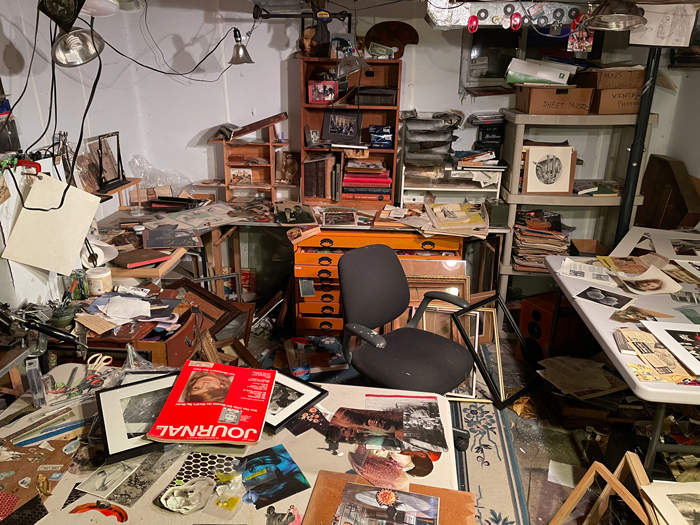
collage. Courtesy of the artist.
FROM KOLAJ 34
Unpacking the Psychology of the Creative Process
“I have scores of vintage LIFE magazines in my chaotic (dictionary definitional use) studio, as well as dozens of vintage books, including books about steam engines, anatomy, photography, insects, and history,” writes Steven M. Specht, Ph.D. in Kolaj 34. “Of course, I also have many contemporary magazines and books from which to choose potential collage elements. Although all of these sources seem quite static as they sit stacked on the floor or on bookshelves; they create the potential for an extremely complex dynamical system. What may seem like a random act of selection of an element, perhaps is not random at all, but determined by a myriad of slight perturbations in ‘initial conditions’ of the artist and the environment. Artists sometimes refer to the role of ‘intuition’ in their creative process. In Simonton’s analysis, this may be the source of ‘blind variations’. I would suggest that intuition (as well as the stacks of vintage magazines) may be akin to the effects of flapping butterfly wings. When I descend into my studio, I may look out of the corner of one eye, and my attention is drawn to an issue of LIFE magazine from 1959; alternatively, I may turn my head, and my attention is drawn to a volume of The Art Journal from 1878. The course of my further explorations and experimentation continues from one of those initial starting points, which may ultimately influence the end-point of the process—the collage that I create. But are those really the starting points—the initial conditions—of the complex dynamical system involved in creating a collage?” Specht’s article, “Chaos, Complexity, and Collage”, unpacks the psychology of the creative process. He writes, “Despite extensive efforts by a number of psychological researchers over the decades, the cognitive complexities of what could be called ‘the creative process’ have remained somewhat elusive.”
This article by Stephen M. Specht appears in Kolaj 34. To read the full article, SUBSCRIBE to Kolaj Magazine or Get a Copy of the Issue.

The course of my further explorations and experimentation continues from one of those initial starting points, which may ultimately influence the end-point of the process—the collage that I create.
This article by Stephen M. Specht appears in Kolaj 34. To read the full article, SUBSCRIBE to Kolaj Magazine or Get a Copy of the Issue.
Steven M. Specht, Ph.D. is a Professor of Psychology at Utica College in Utica, New York and a Signature Member of the National Collage Society. Originally trained as a psychobiologist, he recently re-focused his research on investigating the factors which influence how individuals perceive artwork. His collage work has won several awards and has been shown, since 2001, in group and solo shows in Australia and the U.S., including National Collage Society exhibitions. Specht has written for Kolaj before: “Affinity for the Infinity” appeared in Kolaj 20; “Can I Use This?” appeared in Kolaj 15; and “Just the Right Elements” appeared in Kolaj 14. Learn more at monkeybrain-collagist.blogspot.com.
